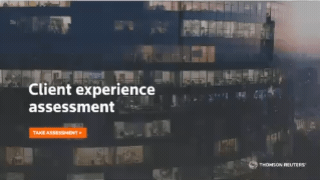Jump to:
| Why are client expectations changing? |
| Signs of a cultural shift |
| The multi-tiered approach |
| Client portals: The go-to solution |
Every lawyer likely has those demanding clients, ones known for the volume and frequency of their requests, and their need to be in near-constant contact. The sort of client who has to be up on every aspect of every stage of every project. Someone who may call their lawyer at 1 AM if they suddenly have a question.
These clients remain eternal. What’s changing is that a growing number of law firms now have an efficient, innovative way to satisfy all of their requests: Thomson Reuters client collaboration tools.
These tools give clients a remote and secure means by which they can monitor the status of all relevant projects and work assignments. Clients can interact with custom-designed systems to get answers to their questions and will have 24/7 access to all pertinent information concerning their ongoing work.
See how easy it is to create a mobile-friendly client dashboard in 3 steps.
Why are client expectations changing?
The growth of portals has been fueled by the COVID-19 era. With so many lawyers and clients working remotely, portal technology quickly became essential to sharing documents, exchanging information, and monitoring the status of deals and other assignments. Now there’s no going back.
“I see this as a new era of work.”
– Eric Sham, LegalTech Solutions Manager, Bird & Bird
Another factor is that many legal departments run lean and are under substantial time and cost pressures—there’s always the need for further efficiencies. Having the ability to use portals for managing projects, getting queries answered promptly, and tracking ongoing costs is invaluable.
And client expectations have changed. In a world in which AI is becoming more prominent by the month, the idea of sending their lawyer an email that may not get answered for days is simply no longer acceptable to clients. A client who once got an expense sheet from their law firm on a weekly or monthly basis will now expect to see how much a project is costing them in real-time.
Signs of a cultural shift
Muzzy Rahman, Client Success Manager at Thomson Reuters, noted in a webcast that there has been a substantial upswing in favor of portal technology.
Law firms “can communicate with customers better and faster, and can share actual use cases,” Rahman said. “When we think about client portals, information is power. We’re seeing it with different firms and hearing it in different conversations.”
The multi-tiered approach
Law firms using client portals will often employ them in a multi-tiered fashion. Portals serve to enhance a firm’s internal operations, making them more productive and efficient. They’re also becoming the primary interface between firm and client.
Eric Sham described his firm’s current use of portals as being a three-point solution.
- For Bird & Bird, portals are a virtual deal room, giving lawyers a centralized place to store and share documents. Doing so “prevents different versions of documents being sent around and not knowing where they are,” Sham said.
- Portals are also essential firm/client relationship hubs. Each client gets a secure login to a standard portal with relevant information about the firm, a set of contacts, RSS feeds, and lists detailing ongoing project statuses, costs, timelines, and other categories.
- These client relationship sites can evolve into more bespoke solutions, with the firm introducing modules to provide greater levels of insight to specific projects and to tailor the portal design to client specifications.
 |
Client portals: The go-to solution
In the webinar, Sham said that offering clients access to a standard client portal is often “a value-add.” The philosophy is that “we have a HighQ platform, and that’s the efficiency you get working with us. It’s like this is a given [when] working with a modern law firm.”
There’s great potential for client portals to continue to expand their functionality. For example, say that a prospective client needs to go through anti-money-laundering screening and compliance requests. It’s now possible for all of this documentation and verification to be done via a portal, with the client learning whether it’s passed the KYC requirements at the end of the session.
With Thomson Reuters, you can deliver an ideal client experience by streamlining collaboration and communication with your clients for all their legal needs on an easy, secure and customizable digital portal. Other firms have already begun optimizing their experiences with client collaboration tools. Very soon, this will be the standard way to conduct business.
 |










